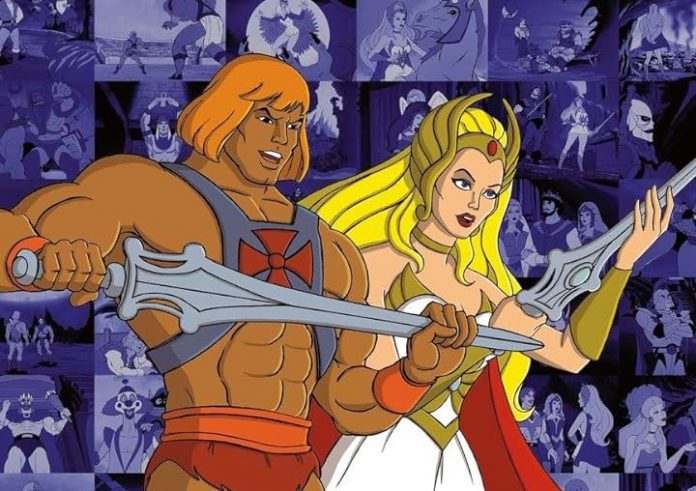Was there ever a pop-culture flame that burned brighter, for a shorter time, than He-Man and the Masters of the Universe? It was just as big as Transformers back in the day, but with nothing like the lasting impact. As cynical as the premise was – essentially a 23-minute toy commercial – the people who created Eternia were all experienced, respected and accomplished writers and artists, and there was some real magic there.
As a young kid it was the first IP that drew me in, so I was actually quite old before I realized that Sci Fi and Fantasy were usually distinct genres. Of course the bare-chested guys with swords are zipping around on jet bikes, firing laser beams at dragons and wizards. Why wouldn’t they?
But I was on the younger end of the fandom and to anyone even a couple of years younger than me, it’s like the whole thing never existed. US toy sales collapsed from $400m in 1986 to $7m in 1987, the live action movie released that year was a dud, and that was the end of He-Man. Mattel opened a window to the glory Eternia with the unabashed goal of picking our pockets for the toys, and successfully strip-mined one single generation of nerds. My generation of nerds.
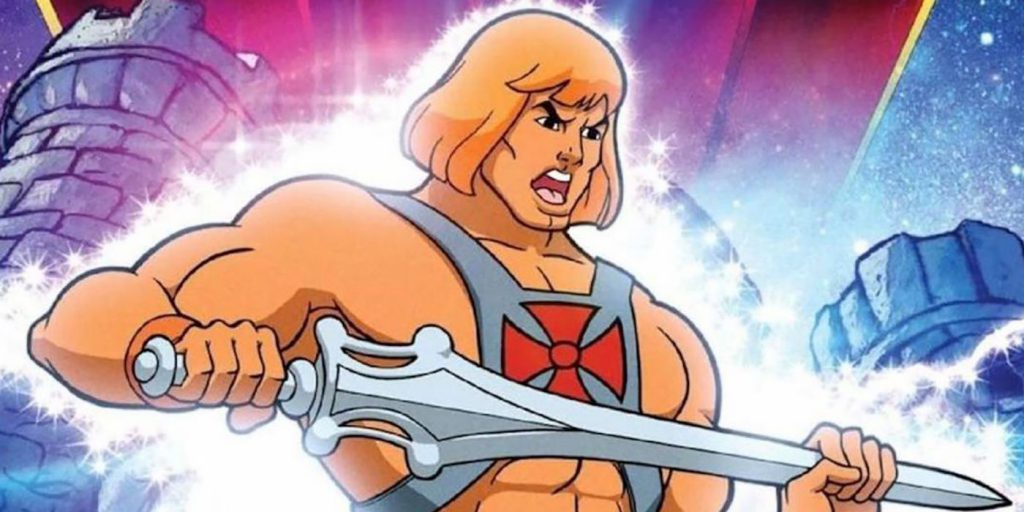
Table of Contents
Boardgame or Wargame?
Clash for Eternia is emphatically branded as a boardgame, although it can certainly feel like a skirmish wargame while you’re playing it – move, attack, roll dice, break skulls. Capture objectives and break more skulls. Publisher CMON is currently Kickstarting a separate system (He-Man Battleground) which itself is marketed as a wargame featuring slightly larger minis, and each expansion kit being an individual “unit”.
Clash, by contrast, is a self-contained boardgaming experience with optional set-piece expansions: if you’re familiar with Hero Quest, that’s probably a good benchmark for the nature of what this is. The core boxed game has a large selection of minis and a full book of scenarios, then the expansions each offer a full new set of minis, one bundle at a time. We’ve got a sandbox here – what’s available is extensive and joyful, but the vision for the release is not to keep dripping out new kits forever in a living ecosystem.
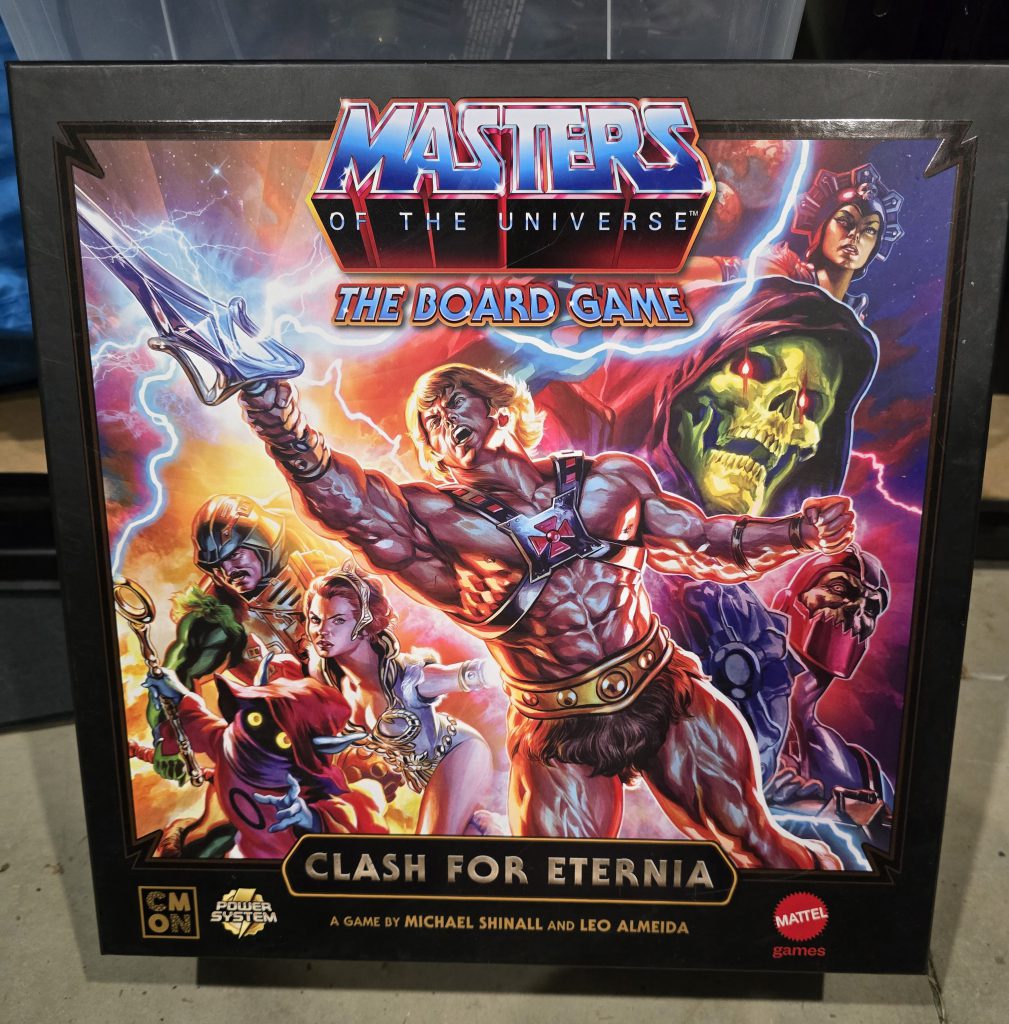
The scope of today’s review is specifically the core Clash for Eternia experience – if demand is there we may circle back and review the expansions separately, but for now we’ll mainly just acknowledge their existence to give a little context around what Clash for Eternia is. And what it is, my friends, a very neat piece of Xennial nostalgia built upon the scaffolding of a well-executed core system.
The Minis
Let’s face facts: If you’re in the market for a He-Man game, you’re probably here for the toys. The game has to be good too, and we’ll come to that very soon, but let’s take a moment to appreciate how damn cool these minis are:

The core box includes a whole bunch of fan favourites, including (of course) the big dog himself plus Skellybob:

Everything comes pre-assembled and the quality is there. If you’re expecting Citadel quality then that’s probably an unreasonable expectation – these are top-end boardgame pieces rather than true wargaming minis. And they’re priced as such.
The A-Listers are all present and correct, including staples of your youth like Teela, Ram-Man and Trapjaw. They paint up very nicely and the physical quality control runs right through this release: the main gaming board and tokens are all high-quality cardboard and even the box it all comes in has a really premium feel. I bought this game with my own money (not a review copy) and I can honestly say that it was worth every cent.
But my favourite character was a semi-obscure dingus!
Same, I was a Mek-A-Nek guy. I think it was because his superpower was so ostentatiously crap that I felt a certain kinship with him – I happen to have a Factor V Leiden Mutation, meaning that own mutant superpower is a heightened risk of blood clots. Cop that, Magneto! But also I had the toy and it was insanely satisfying to just rotate the mini back and forth as his neck wound up and down. It’s the same tactile sensation that still today has made fidget spinners a thing.
Anyway. Whoever your favourite character is – yes, even that guy – they’re in the game, though they can’t all be in the core box. There’s a couple of expansions that made it to retail: She-Ra and her chums, Hordak and his mob and a specific Assault on Castle Grayskull scenario. So if you’re keen on those, you should be able to pick them up easily enough. I know I was delighted to have Modulok in this game, an endlessly creative toy that I played with long after the rest of my He-Man collection was bagged up and dumped in the attic.
Beyond that, there’s a Snake Men expansion and Box of Power which were Kickstarter exclusives. The latter in particular is a very nice acquisition if you can find it – they did reopen the KS recently, so keep an eye out for that happening again, but otherwise you’re looking at the second hand market if you’re here for Buzz Off and Snout Spout.

Game Mechanics
The rolling fields of Eternia are represented in the core set by a (very nice) hex-based map, with the rich ochre background offset by beautifully saturated colours in a pallet that points towards the classic Filmation series, and is even reminiscent of Fury Road / Furiosa in some ways. The colours are drenched and if you’re planning to paint your minis – and especially if you’re picking up the 3D terrain – there’s a lot of fun to be had there.

You can play vs AI, but at its heart this is a 1 vs Many game, and that’s the experience this review will focus on. We’ve got two different paradigms for the two sides, termed here as Player(s) and Controller. Both sides get four activations per round. The Controller is a pseudo-GM who also gets to play themselves: they take 3 characters and activate them once each per round, with a 4th “Strategy” activation for their Minions (1 Wound goons whose role in life is to (A) clog up the board and (B) make the Heroes look epic when they smash a whole bunch in one activation), as well as providing the window of opportunity to use a couple of special abilities and cards.
The Players, by contrast, take control of one character each; they still get 4 activation slots regardless of how many characters they’re packing, meaning that some may activate more than once per round if they’ve brought fewer than four.
Important to note is that the Controller does not have to be the Bad Guys. It may well start out that way if you’re bribing your friends to play with you by telling them they can be He-Man, and that you’ll happily take up the punchbags, but there are Controller and Player versions of every character, and indeed some missions (such as The Siege) actively suggest using the Goodies as the Controller side because it makes thematic sense.
Clash is, at its heart, a Move-Attack game: players take turns to activate a character who gets two actions, the most common of which you can probably guess. It’s worth noting that in this game you can perform the same action twice, so if you start in range to double-tap you’ll have the opportunity to swamp your opponent under a barrage of clubbing blows.
This is where the first piece of elegant design comes in: there’s a Turn 0 minigame each round where the two sides take turns placing their cards face down to determine activation sequence. The later you activate a character, the more Power they get when they do activate; at the cost (and risk) of not getting to do their stuff first.
And speaking of Power, this is an in-game currency that you spend on doing the good stuff. You earn little gold cubes in-game and allocate them to various skills and attacks – it essentially unlocks your super powers.
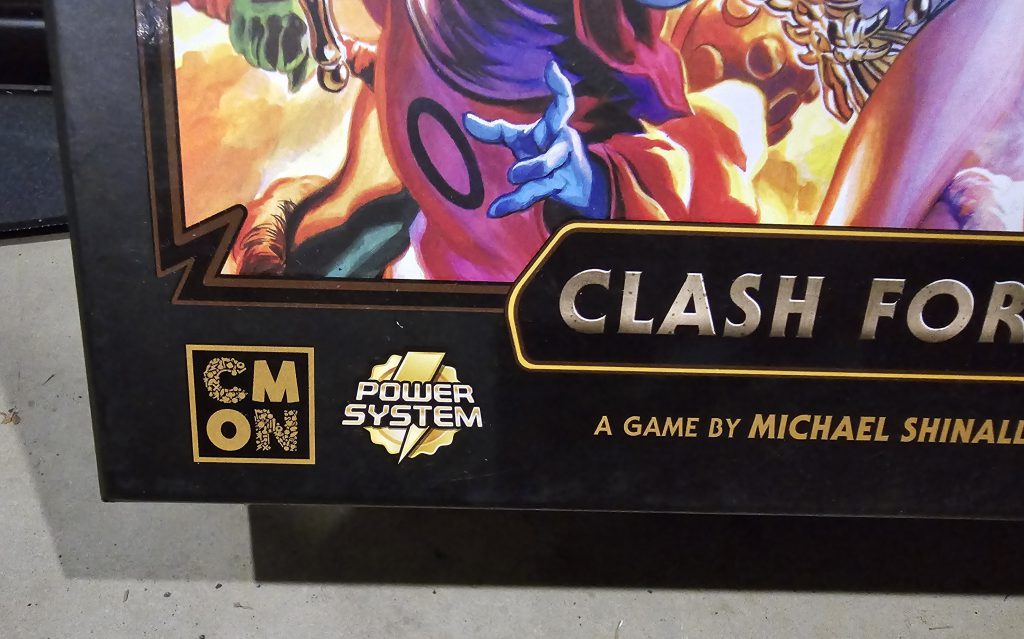
The devs seem super proud of this, and it’s plastered all over the game and expansions with its own branding, so keep an eye out for this one popping up again on future licenses. If we all get a vote here, mine go to M.A.S.K. and Thundercats in that order.

There’s a rule called Balance of Power that understandably annoys new players – when the Players spend their Power, it goes to the Controller’s stack rather than back into the “pool”, and this will feel imbalanced in your early games. What I would point out is that the Players do get more Power every turn just from the way the Activation board is set up; Power-starving the Controller at key moments provides an extra tactical element; and it’s easy to be swayed by the fact that the first Scenario in the booklet is already comically imbalanced in favour of the Controller, so that can sway your perceptions.
Yeah. About that.
The Missions
They are…a mixed bag of lollies.
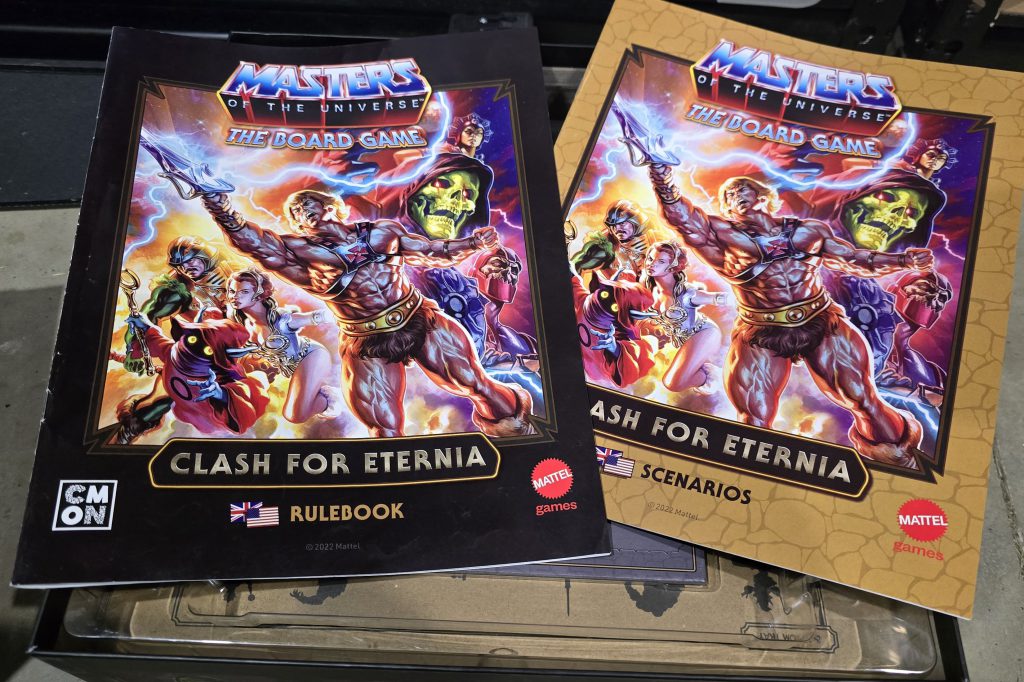
The opening mission is notorious amongst the playerbase, in the sense that it’s a notoriously bad introduction to the game. The missions aren’t balanced – don’t expect them to be balanced – but the first mission really should have been set up to give people a smoother experience than this does.

It heavily favours the Controller, which means the majority of your group is going to find their first experience an absolute slog. And what’s worse is that they don’t even get their ass kicked quickly and move onto the next one – it’s a grim quagmire. The Controller is heavily incentivized to just bog the Players down with respawning Minions (thanks to their generous respawn locations) and slowly (very slowly) farm their characters for kills.
My advice? Don’t play this one first. Skip straight ahead to the second mission, and you’ll have an absolute blast. Win conditions based on kicking each other’s asses and grabbing objectives in the middle of the board – now you’re talking!

You’ll find that the scenarios are pretty creative in what they ask of you, but they’re all over the place in terms of balance (and in some cases, frustration levels). How you feel about this is really up to you – if you’ve got time and energy to pour into this game as a group, that can be rewarding in its own way. For example you can always circle back to Rescue as a hard-mode challenge once you’re more experienced.
If you want to get there a little bit quicker, the community on BGG has laid out their views on which missions are better and worse to get stuck into. You’ll notice that even in this thread, there are cases where people disagree over specific missions, and someone found that it played out very differently when the Players approached it in a different manner. So if your group is able to invest in this game, that voyage of discovery is real – but the linked thread gives you a great starting point if you’ve got limited time for Clash, and want to skip straight to the consensus good bits.
You’ll also notice that a lot of the criticisms are on the lines of, “Cool idea, but this mission would work a lot smoother if they placed the spawn points or objectives here instead of there.” Well, the even better news is that experienced community members have collected a few of those pointers in one place. Based on my own experience of this game, I’d honestly recommend making that thread your starting point for those missions. I’m not going to claim I’ve played every single one both out of the book and with the suggestions linked above, but from what I do know, the suggestions are all straightforward improvements and I’d back them all blind.
So, Is It Fun?
Hell yes it’s fun! As a fan of the franchise I am wildly biased and I would never not enjoy playing with He-Man toys. But to give you a feel for the kind of decision points it creates, imagine you’re playing 1 vs 3. The Controller is flying solo and they’ll do whatever they’ll do, but the Players will have 4 activations between the 3 of them, which they need to dictate at the start of the round – meaning someone gets to go twice.
Which player’s character gets to go twice? Chances are you’ll have a couple of people making their pitch for why it should be their guy. But then you’re talking about your plans for the Round right in front of your opponent, so you’ll try to do it with a nod and a wink as much as you can – and then you’ve also got to reach consensus on who goes in which order. This game generates a lot of these social interactions, where supposed team mates have to tread the line between banter and blood vendettas.
Another really cool element to this game is the escalation points. You’ll hit three moments in every game where you get to apply a choice of upgrades of escalating power – you hit the trigger and you get to do something really cool. You’ll pull out the upgrade cards, check both sides to see which one you’ll take, and regularly experience “I get to do WHAT?!” moments – all the way up to slamming He-Man on top of Battle Cat. Hell yeah!

The structure of the game – Controller vs Players – also makes it eminently easy to roll out among your friends. If you take on the role of Controller, you can teach a group of friends as you go, so it’s a pretty easy sell. Clash for Eternia really couldn’t be set up any better for one person to buy the game, get a grip on the rules and then go forth and multiply.

Replayability
In a word: extensive. The core scenario booklet comes with an impressive suite of missions to explore, all asking different things and often with asymmetric win conditions; and you can have a lot of list-building fun configuring your team. Picking your favourite characters from the cartoon; looking for a blend of archetypes (Stratos for speed, Orco for unpredictable magical insanity, Teela for summoning Royal Guards to bolster your ranks); fine-tuning your approach for the scenario (“Wait a minute – if I take Stratos, and activate him last, he’ll have enough Power to speed-boost over to that Objective in Round 1”). There’s a lot you can mess around with before you even get to roll a dice in anger, and then you’ve got the in-game upgrades to play with on top.


If you get frustrated by glitches and nits, then you’ll definitely get frustrated with Clash for Eternia. I personally saw my main role as Controller to be keeping the game flowing and making sure that my Players had a great experience – which sometimes meant making an captain’s judgment call on how I thought something should work, then maybe going back the next day and checking if I got it right. I did not see my main role as making people sit there for long stretches while I triple-checked the rule book, and certainly not as smashing them mercilessly into the dirt. I say this as a competitive wargamer myself – that’s not what this is, and if you’re working Clash into your rotation, you’ll probably want to take a night off from the Ruthless mindset.
I think the way to approach this game is to understand that you’ll accidentally break it sometimes. Playing consecutive games of Clash has its own rhythm – when a mission feels balanced, you’ll just have fun fighting straight out of the box. When it doesn’t – you’ll figure out which configurations of heroes or villains give you the best chance of doing what the mission asks of you, and you’ll finally beat it. And now that you’ve got it cracked, you can go back and beat it on hard mode with characters you already know are poorly suited to the task, or just a themed team. All fliers (like Stratos and Buzz Off) zooming around the board at light speed; all Wizards like Orco and Sorceress fighting shoulder to shoulder in a brawling scenario; Nothing But Animals. Go nuts.
Is this cope? If you argued that the publisher of a multi-million dollar boardgame should not rely on community comp to patch the playing experience back together, then I wouldn’t argue with you. I can certainly imagine that any potential future Power System releases will be playtested a little more thoroughly before being unleashed into the wild. But I honestly think they could lose a little of their charm along the way too. Clash for Eternia is not a balanced wargame, and breaking it doesn’t make you clever. In large part it actually arrives pre-broken, and piecing it together is part of the experience.
Now, having established that – if you want to play it as a wargame, you can play it as a wargame. The core experience of Push Minis Forward To Whack Each Other Near Objectives certainly feels like it could slot straight into a skirmish minis game – and there are fan mods that achieve exactly that:
https://boardgamegeek.com/filepage/272365/epic-scenarios
https://boardgamegeek.com/filepage/263566/brawl-scenarios
The legends on Boardgame Geek has put together scenarios with symmetrical and consistent win conditions, and now you’re ready to build your “list” and march to war.
Summary
Strengths
+ Sublime fan service
+ Core box is packed with all the Rock Star characters
+ Minis and other components all excellent quality
+ 1 hour game time for experienced players makes it a live weeknight option
+ Tremendous replayability
+ Core mechanics flow like a dream
Weaknesses
– Missions are mixed quality
– For what is a simple core game, you’ll need to invest a few reps to really “get” it
– Limited availability of Box of Power will leave you wanting more
Further reading
The excellent Battle Ram blog is an endless source of joy for nerds of a certain age.
He-Man is notably prominent in queer culture, and here are a couple of thoughtful articles on that topic specifically.
And if you just want to see Skeletor talking smack, here’s his greatest hits.
The Verdict
Clash for Eternia can just slot right in to anyone’s gaming portfolio. For my own group, it’s a pallet-cleanser that you can comfortably blast out on a weeknight or when you’re looking for a relaxed and social night of beers, swords and sorcery.
For others, the appeal will be going in deeper, like those long summer holidays when you and a schoolfriend would play the crap out of one game for weeks on end. I guarantee that there will be people out there right now having fun by crafting together 3 linked scenarios together in little campaigns.
Clash for Eternia is not without its flaws: the missions needed a tidy up, and the community has stepped in already to make that happen. Is it worth buying if you can’t get the Kickstarter expansions? 100% yes, and it’s massively replayable even without them, but if you know yourself and know you’ll be yearning for them, it’s a factor.
Ultimately I can tell you with some confidence that you’ll like Clash exactly as much you want to like it. Me? I wanted to love it, and I did love it. It’s a worthy showcase for the IP, the minis are sweet and it’s fun. Clash slots neatly into what we wanted from a side game, which is a polite way of saying that gives us something to do while we’re drinking in my friend’s kitchen.
I liked it so much that I went back in on the reopened Kickstarter and bought the whole lot. So here we are, 40 years down the track, and Mattel are still picking my pocket for He-Man toys, but now I’m drinking and eating pizza while I’m playing with them. Teenage me would have seen that as something to aspire to, so I guess sometimes dreams do come true.
